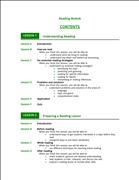
Essentian Reading
What types of texts do we read in everyday life?
How do we read in real life?
Differences in reading material
Texts in Cambridge English exams
Types of tasks to assess reading comprehension
Tips for classrom practice to improve learners' reading skills
Effect of Dyslexia on Foreign Language Learning
Dr. Judit Kormos, Reader in Second Language Acquisition at the Lancaster University (UK), explains how to help dyslexic students that have "learning differences" when it comes to acquiring a foreign language - English. A small obstacle can seem like a big hurdle for these students, and teachers must show them how to jump over these hurdles and alter the racing track for them. In the end, the chances they will give up will be smaller and dyslexic language learners can reach the finish line alongside their other classmates.
Accommodating Dyslexic Learners
Dr. Anne Margaret Smith of ELT Well, a DysTEFL expert, gives easy tips and advice on how to accommodate students with learning differences to make them feel inclusive. Watch this video to learn things you can do that doesn't cost any money or take up much time to make your classroom an easier place for students with dyslexia to work in, while benefiting other students.
Role of Information Technology
In this talk, Dr. Margaret Crombie, an independent education consultant in Scotland, shows how the role of Information Technology (IT) supports students with dyslexia learning English as a foreign language. What does this involve? Not only does it cover the basics, such as computers, the Internet, various devices like Interactive whiteboards, tablets, phones, and software as well. But most importantly, how it all relates to communication - because that is what we learn another language for.
Developing Phonological and Orthographic Awareness
Professor Joanna Nijakowska from the Department of Pragmatics at University of Łódź in Poland, concentrates her talk on sample principles and techniques which can be used for developing the knowledge of word sound structure and sound-letter relations in order to help dyslexic learners read and spell skilfully in English. Professor Nijakowska goes into detail and shows what a multi-sensory structured learning approach is, which is one of the most frequently recommended teaching methods for dyslexic learners.
Наталия Ивановна Галанина, ведущий методист издательства "Макмиллан"
These ELT Teacher Training Videos from Oxford University Press India aim to address significant and common issues in day-to-day classroom teacher-student interaction.
These ELT Teacher Training Videos from Oxford University Press India aim to address significant and common issues in day-to-day classroom teacher-student interaction.
Coaching elementary readers to use the reading strategy of making predictions based upon a passage of text. This teacher is using the instructional model presented in Lucy Calkins' Units of Study for Teaching Reading program. The teacher explains to the students how to focus on details presented in the narrative to make predictions using post-it notes and determine what is likey to happen to characters next.
The goal in teaching reading sub-skills is to increase a student's comprehension and vocabulary, and this can be done by using a variety of texts, such as textbooks, novels, poems, newspaper articles, diaries and advertisements. Teach children how to judge what text might be from the article's title with help from an English specialist and president of a theater group in this free video on reading.
Teaching whole group reading skills using the thinking partners interactive read aloud strategy. Linda Hoyt's Interactive Read-Alouds will help you make the most of this time by showing you creative ways to use popular children's literature to teach specific standards and build fluency and comprehension. Combining guided conversations with reflective thinking, Linda's read-aloud lessons engage children in strategic listening, speaking, reading and writing about text.
How to Teach Reading? Strategies and Techniques | Best Practices
Summarizing is a student's ability to be able to identify the main idea and supporting details with a particular work. Find out about great teaching strategies for using summarizing for comprehension with help from an educator-turned accomplished author and passionate speaker with a heart for healthy relationships in this free video clip.
Reading games for middle school stations are a very engaging way to get your students actively involved in learning. Find out about reading games for middle school stations with help from an educator-turned accomplished author and passionate speaker with a heart for healthy relationships in this free video clip.
Multiple meaning words can be a problem for even the most proficient of readers. Get reading instructions for multiple meaning words in middle school with help from an educator-turned accomplished author and passionate speaker with a heart for healthy relationships in this free video clip.
Teaching a retelling reading strategy for primary students comes down to a student's ability to recall what happened. Teach a retelling reading strategy for primary students with help from an educator-turned accomplished author and passionate speaker with a heart for healthy relationships in this free video clip.